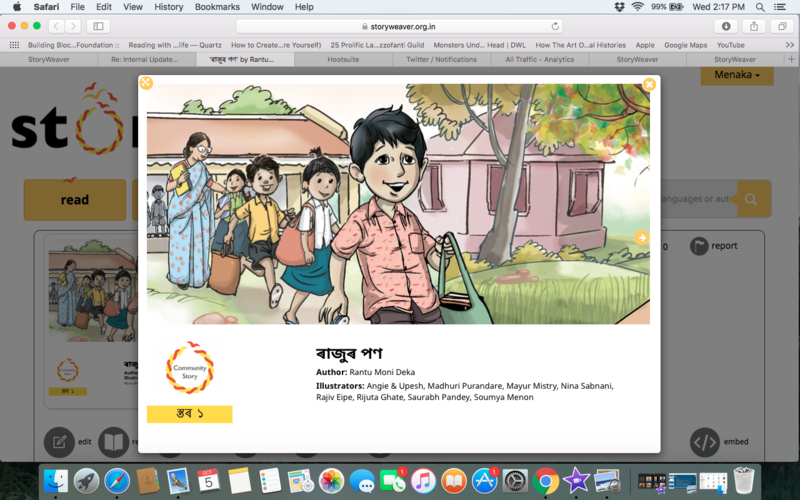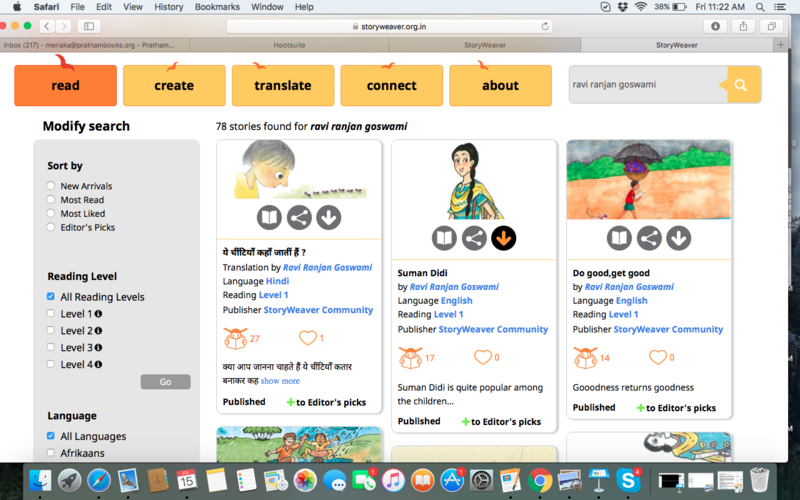A classical language for a new generation
Posted by Remya Padmadas on October 14, 2016The language referred to as Saṃskṛta, "the cultured language" has long been venerated as a sacred, philosophical and classical literary language. A lingua franca in Greater India, today it is listed as one of the 22 scheduled languages of the country.
The 2001 Indian census reported that 14,000 people identified Sanskrit as their mother tongue and in 2010 Uttarakhand was the first state in India to declare Sanskrit as an official language.
Long looked upon as a classical language, in recent years a movement to revive Sanskrit and introduce it to a new generation of learners has emerged. Podcasts, blogs and websites are attempting to take a language that traces its origins to approximately 1500 - 2000 BC and make it relevant to a generation that is plugged in to Google and YouTube. StoryWeaver is proud to play a small role in the efforts of one organisation working in this realm.
StoryWeaver’s Sanskrit Journey
When StoryWeaver launched in September 2015, the digital open source repository of children’s stories had 24 languages. Within weeks of the launch, requests for new language additions began trickling in. One of them was for Sanskrit.
The request came from volunteers at Samskrita Bharati, a not-for-profit organisation, with its headquarters in New Delhi, and branches in Bangalore, India and San Jose, California. The organisation has been working to revive Sanskrit, in a number of ways. Their 10-day spoken Sanskrit classes are extremely popular and routinely organized all over India and in many major countries worldwide. Students learn conversational Sanskrit in a two hour class every day over a ten-day period and develop the ability to start having Sanskrit conversations.
Vikram Gakhar and Sreenivasan Chakrapani, both volunteer their time and efforts at Samskrita Bharati. It was at Vikram’s behest that Sanskrit was added to StoryWeaver, and in the 10 months since StoryWeaver’s inception, a growing community of Sanskrit enthusiasts have helped created a repository of children’s stories in the language on the site.
Mr Chakrapani is a former electrochemical engineer with a flair for languages. Fluent in English, Tamil, Hindi, Kannada, Italian and German, he chose to pursue the study of Sanskrit post retirement.
“An inner urge took me to Sanskrit soon after retirement. I studied full time and set a target to myself: to be able to write in Sanskrit in two years and teach in the third year. I then volunteered to work for Samskrita Bharathi. They trained me, despite my advanced age, to conduct spoken Sanskrit camps. Since then I am doing my part on a small scale.” shared Mr. Chakrapani.
Mr. Chakrapani has conducted 10 spoken Sanskrit camps so far, and was introduced to StoryWeaver by his colleague at Samskrita Bharathi: Vikram Gakhar.
Vikram is a full time engineer and a part time Sanskrit student/teacher/translator. “I teach Sanskrit to a group of 10 students at my workplace and try to create new material in Sanskrit whenever I get time. I came to know about StoryWeaver from the Pratham Books team at a storytelling session I attended in 2015.”
Both Mr. Chakrapani and Vikram use StoryWeaver to translate stories to Sanskrit with the intent of sharing them with students to help them improve their spoken Sanskrit skills.
“Translating stories on StoryWeaver serves a number of purpose. Creating simple reading material is useful to new students of Sanskrit. It's a fun and effective learning tool for my students which helps them exercise their knowledge of grammar to form sentences. Also, since the stories are available in multiple languages on the platform, one can read and understand the Sanskrit version first and then read the same story in a more familiar language to find out what they didn't get the first time.” shared Vikram.
74 year old Mr. Chakrapani admitted to not being very tech savvy, but found himself using StoryWeaver to translate with ease, thanks to its simple and intuitive user interface.
“We have a large student group and we circulate the translated story link via emails. Even the elders on the group have responded well, with grown ups wanting to read these children’s stories!” enthused Mr. Chakrapani.
Sujatha, another active translator, traces the origins of her translation work on StoryWeaver back to Samskrita Bharati too. An alumnus of the 10 day speaking course, she started reading children’s stories to improve her language skills before progressing to novels in Sanskrit.
“Translating stories for kids is a good way to start one’s learning journey as the language is simpler and helps one gain confidence. StoryWeaver has been a wonderful place for me to practice and hone my skills. ”
Sujatha shares how a dedicated group of Sanskrit enthusiasts get together every evening to converse in Sanskrit and share resources.
“Our group logs on to a Google Hangout every night at 9pm. Whoever is free can join in. We speak to each other in Sanskrit about everything from current affairs to what we are reading. We also use a Google group to document and share the translations we create, including the ones on Storyweaver. This way, it’s easily accessible to everyone.”
StoryWeaver is proud to have collaborators like Mr. Chakrapani, Vikram, Sujatha and their fellow language lovers Suneesh Namboodiri, Govindraj Kasul, Sini Mukundan and Anand Viswanathan. We look forward to seeing more translations by them on the site, and hope that we can be instrumental in sharing them with more people across the world.
Further reading and listening
Sudharma, is the only Sanskrit newspaper in publication today. Printed in Mysore, Karnataka, you can read an online version here.
Balamodini is a podcast of Sanskrit stories read by Samskrita Bharati volunteers from the Sambhashana Sandesha Sanskrit Magazine.
comments (2)
An Assamese book in every child's hands
Posted by Remya Padmadas on October 18, 2016
"যিদিনাই প্ৰত্যেক শিশুৰ হাতত এখন সহজে বুজি পোৱা অসমীয়া কিতাপ থাকিব মোৰ অনুবাদ সফল হ'ব"
"My translations will be a success when an Assamese book with illustrations is in every child's hand."
When we told you in a previous blog post, that Rantu Moni Deka, is a man on a mission, we weren't joking. He's translated 15 stories to Assamese on StoryWeaver, and written the first, orginal Assamese community story too!

Rantu sent us a lovely message on International Translation Day which we wanted to share with our readers.
"First of all Thanks to Pratham Books StoryWeaver for giving us a platform for doing something for the lovely kids. Learning depends on the ability to read. When children have access to enjoyable, enriching stories in their own languages, the transformation in their reading skills are visible. The sheer joy of reading stories that are engaging and capture their imagination can make children become readers. Which in turn, makes them better learners.
Assam Govt. students have access to libraries in school, but the books are not proper for them and so the children ofcourse are not interested in them. But they love StoryWeaver stories which have been translated to Assamese. The children feel so happy with the colourful illustration and a story that is easily understood by them. If these storybooks are available in their school library and also in the village library where the children meet together in the evening then my dreams will come true.
I will encourage others to use StoryWeaver and will try my best to translate more stories to Assamese so that children can read all the Pratham Books stories in their hands."
Be the first to comment.मेरे बचपन से स्टोरीवीवर तक… ( एक संस्मरण )
Posted by Remya Padmadas on September 22, 2016
बचपन मैं सभी बच्चों की तरह मुझे भी कहानी सुनने का बड़ा शौक था। खुशकिस्मती से मुझे कहानी सुनाने के लिये घर में अनेक लोग थे जैसे दादा-दादी, माता-पिता, भाई-बहन। ननिहाल जाते तो वहाँ नाना-नानी, मामा, मौसी...। कहीं भी हम होते रात को किसी न किसी से कोई न कोई मज़ेदार कहानी(यां) सुनकर ही सोते। मैं जब थोड़ा बड़ा हुआ और पढ़ना सीख गया तो अखबार और पत्रिकाओं में बाल साहित्य पढ़ने लगा। इस तरह कहानियां पढ़ने-लिखने का शौक लगा।
स्कूल के दिनों में छुट्टियाँ खेलने कूदने और कोमिक्स, बाल पत्रिकाओं में छपने वाली कहानियाँ, कवितायें या बाल उपन्यास पढ़ने में बीतती थीं। नन्दन, लोटपोट, चंपक, चन्दामामा - कुछ नाम याद हैं। चंदामामा में कहानियों के साथ छपने वाले चित्र और कहानियाँ बेहद रोचक होते थे।
जब मैं झाँसी में कक्षा आठ में पढ़ता था एक दिन मैंने एक छोटी-सी कविता लिखी और भाई-बहनों को सुनायी। पहले उन्हें भरोसा नहीं हुआ की मैंने वह कविता लिखी है। उन्हें लगा कि झूठी शान दिखाने के लिये मैं किसी और की लिखी हुई कविता सुना रहा हूँ। मैंने उन्हें शपथ लेकर कहा तो माने और उन्होंने कविता की तारीफ की। वह कविता मैंने दैनिक जागरण के बाल मण्डल के संपादक को प्रकाशन के लिये भेज दी। संयोग से वह स्वीकृत हो गयी और कुछ दिन बाद प्रकाशित हो गयी। समाचार पत्र में छपी अपनी रचना को देखकर मुझे बड़ी प्रसन्नता हुई। परिवार और पड़ोस के लोगों ने भी तारीफ की और मेरा उत्साह बढ़ाया। फिर कभी-कभी मैं कविता, कहानी, लेख इत्यादि लिखने लगा। उनमें से कुछ स्कूल और कालेज की पत्रिकाओं और स्थानीय समाचार पत्रों में प्रकाशित हुए।
नौकरी में आने बाद व्यस्तता बढ़ी और वातावरण बदल गया जिससे मेरा पढ़ना-लिखना बहुत कम हो गया । फिर विवाह हुआ और एक पुत्री का पिता बना। मैं, मेरी पत्नी और पुत्री अब एकल परिवार की शक्ल में, घर से दूर, एक दूसरे शहर में थे। जब पुत्री थोड़ी बड़ी हुई तो मेरी कहानियों में पुनः रुचि हुई। मैंने उसके बचपन में उसे, अपने बचपन की कहानियाँ सुनायीं और कुछ अपनी कल्पना से पिरोकर नयी कहानियाँ भी बनायीं। उसे कहानियाँ सुनने में आनंद आता था और मुझे सुनाने में। फिर वो बड़ी हो गयी अब उसे कहानियाँ सुनाने की आवश्यकता नहीं रही।
कभी-कभी मैं लिखता रहा, लेकिन मैंने बाल साहित्य नहीं टटोला था। हाल ही में इन्टरनेट पर कुछ खोजते हुए मुझे https://storyweaver.org.in/ मिला तो मुझे आश्चर्यजनक प्रसन्नता हुई। यह बच्चों और बड़ों, दोनों के लिये, रुचिकर है, सुगम है और निःशुल्क है। इसने मुझे बच्चों की कहानियों की तरफ पुनः आकर्षित किया और मैंने कुछ कहानियाँ लिखीं। बड़ा अच्छा लगा जब अपनी हिन्दी कहानी का अंग्रेजी और तेलगु अनुवाद देखा। इस साइट पर बच्चे भी आसानी से अपनी कल्पना से चित्र सहित कहानियाँ लिख सकते हैं।
स्टोरीवीवर (https://storyweaver.org.in/) बच्चों के लिये बहुत उत्कृष्ट समाज सेवा का कार्य कर रहे हैं। मैं इन्हें बहुत बधाई और शुभकामनायें प्रेषित करता हूँ।

रवि रंजन गोस्वामी की बुनी हुई कहानियाँ पढ़ने के लिए यहाँ क्लिक कीजिए…
Be the first to comment.